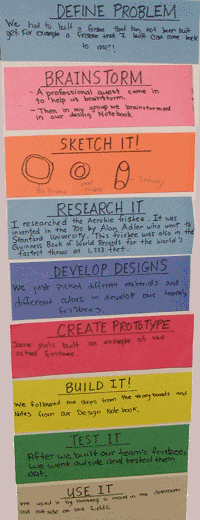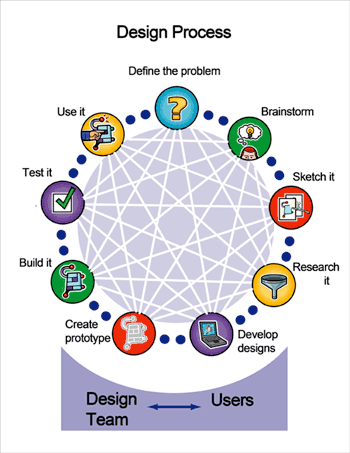Design
ICT4me is fundamentally a curriculum about design. The way in which the curriculum was developed using an Understanding by Design framework, a term that focuses the design of curricular materials on the ultimate goal of understanding rather than memorization or coverage. Each unit, therefore is guided by a set of Enduring Understandings—the big ideas of a discipline. The big ideass in ICT4me draw from the disciplines of computer science and mathematics.
The basis of the entire ICT4me curriculum is the Design Process, an iterative, interconnected cycle that can involve users at a few or many stages of the process. Every unit engages youth in all stages of the Design Process, sometimes emphasizing or repeating one stage more than others. At the end of every session, youth reflect on the stages they used.
There are nine stages in ICT4me's Design Process:
Define the problem.
Brainstorm.
Sketch it.
Research it.
Develop designs.
Create prototype.
Build it.
Test it.
Use it.
In ICT4me, youth develop designs for an improved frisbee, shoes, a Perfect Hangout, a blog, a website, a network and a computer game. In some cases, youth even get to create their designs (website, computer game). To help them through the process of design, each unit includes Design Requirements - minimum specifications that scaffold the youth emergent understanding of the design process and the facilitator's assessment of youth understandings.
The Design Notebooks are binders with paper and pockets where youth can capture their designs and ideas for designs. Professional designers use notebooks and other tools, often online, to keep track of designs and ideas. The Design Notebooks serve two main purposes in ICT4me:
- to reinforce for youth that they are designers; their designs are important and worth keeping
- to provide summative pictures and text of what happened in the unit. Program leaders may decide to use these at Family Tech Night.
Youth summarize their work on flying objects.

Managers/Coordinators/Directors
 |
© 2013-2016 SRI International. 333 Ravenswood Ave. Menlo Park, CA 94205. Produced by the Center for Technology in Learning at SRI International with support from the National Science Foundation under Grant Nos. 1339181, 1232461, and 0524762. Any opinions, findings, conclusions, or recommendations expressed are those of the authors and do not necessarily reflect the views of the National Science Foundation. |

|


